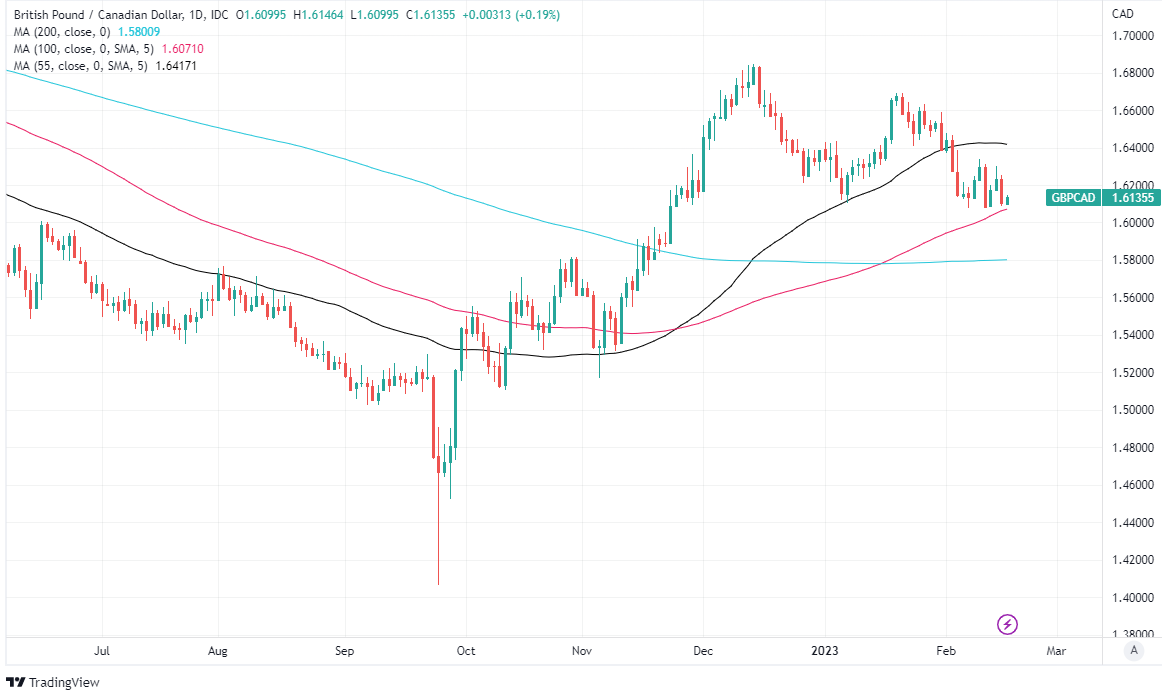Canadian Dollar Charts Warning of GBP/CAD and EUR/CAD Vulnerabilities
- Written by: James Skinner
-
"A low close on the month may be needed to add to bearish momentum" - Scotiabank.

Image © Adobe Stock
The Canadian Dollar has remained an outperformer among major currencies in recent trade but technical studies of the charts suggest it could have scope to rise further against Pound Sterling and the Euro in the days and weeks ahead.
Canada's Dollar was the best-performing currency in the G10 contingent for the week and month on Thursday after rising further against most major counterparts in recent days amid broad gains for stock and commodity markets.
The Loonie's gains and weakness in Sterling have kept GBP/CAD grounded close to the round number of 1.61 while prompting short and medium-term trend signals to warn of a reversal underway for a multi-month uptrend that dates back to September's all-time low.
"Initial support remains pretty firm at 1.6105/10 and the base of the downward slopping channel lies at 1.5990 currently, which should provide the GBP with some underpinning," says Shaun Osborne, chief FX strategist at Scotiabank.
"A low close on the month may be needed to add to bearish momentum," he adds in a Monday review of the Canadian Dollar charts.
 Above: Pound to Canadian Dollar rate at daily intervals with selected moving averages. Click image for closer inspection.
Above: Pound to Canadian Dollar rate at daily intervals with selected moving averages. Click image for closer inspection.
The bearish connotations of the short-term trend momentum indicators are seconded by a potential "longer run top/reversal" pattern now also embroidering the appearance of vulnerability into the monthly intervals charts.
Sterling initially rose against the Canadian Dollar in Monday and Tuesday trade but its recovery was curtailed in the mid-week session when both UK inflation rates surprised sharply on the downside of market expectations, leaving GBP/CAD little changed on the week by Thursday.
The softer UK inflation data was followed by widespread losses for Sterling exchange rates suggesting the market interpreted them as meaning the Bank of England (BoE) is less likely to lift Bank Rate further as a result.
The Pound is merely one of many currencies at risk of further losses relative to the Canadian Dollar, however, with the European single currency being another.
"Weakness below the range base at 1.4240 would likely trigger a slide in the cross to the 1.3880 area (measured move downside potential, assuming a double top pattern)," Osborne says in reference to EUR/CAD.
 Above: Euro to Canadian Dollar rate shown at daily intervals with selected moving averages. Click image for closer inspection. To optimise the timing of international payments you could consider setting a free FX rate alert here.
Above: Euro to Canadian Dollar rate shown at daily intervals with selected moving averages. Click image for closer inspection. To optimise the timing of international payments you could consider setting a free FX rate alert here.
"Trend momentum is tilting EUR-negative; the intraday and daily DMI patterns are tilting bearish. Longer run trading patterns are also shaping up bearishly for the cross, potentially implying a major peak/reversal is developing around the Jan/Feb highs. Resistance is 1.4450 and (major) 1.4650," he adds.
Europe's single currency had risen similarly to Sterling after appearing to benefit from Eurostat data telling on Tuesday of a pick up in employment across the Euro area late last year when the workforce grew by an upwardly-revised 0.3% in the third quarter and a larger-than-expected 0.4% in the final quarter.
But while the Euro has been more resilient than Sterling, perhaps owing to hawkish comments from European Central Bank (ECB) policymakers, the outperforming Canadian Dollar has still kept EUR/CAD suppressed near 2023 lows through much of the week.
"At our latest meeting on 2 February we decided to raise the key ECB interest rates by 50 basis points and we expect to raise them further. In view of the underlying inflation pressures we intend to raise interest rates by another 50 basis points at our next meeting in March, and we will then evaluate the subsequent path of our monetary policy," ECB President Christine Lagarde told the European parliament on Wednesday.
"Keeping interest rates at restrictive levels will over time reduce inflation by dampening demand and will also guard against the risk of a persistent upward shift in inflation expectations. Our future policy rate decisions will continue to be data-dependent and follow a meeting-by-meeting approach," she added.











